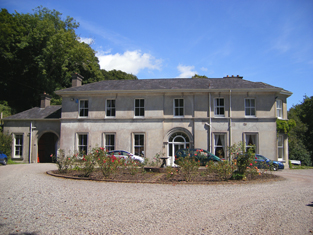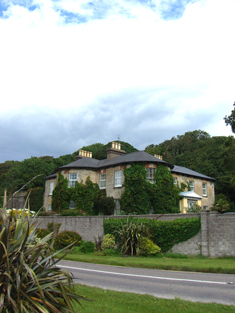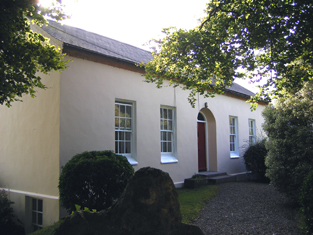Cuskinny
Houses within 5km of this house
Displaying 25 houses.
Houses within 5km of Cuskinny
Displaying 25 houses.
| House name | Description | |
|---|---|---|
| Corkbeg | The Penrose Fitzgerald Papers in the Boole Library document the building of a mansion house at Corkbeg in the 1820s. It was built to replace an earlier house mentioned by Wilson in 1786 as the seat of Robert Uniacke Fitzgerald. It was held in fee by the Fitzgeralds and valued at £65 in the early 1850s. By 1906 it was valued at £81. Bence Jones writes that the Fitzgeralds sold Corkbeg in the mid 20th century. The Irish Tourist Association survey notes that it functioned as a hotel for a few years. It was demolished in order to establish an oil refinery. | |
| Rock Cottage (Barnahely) | William Warren was leasing this property to Richard Foott at the time of Griffith's Valuation, when it was valued at £11 5s. A house is still extant at the site. | |
| Fota House | Originally built as a hunting lodge for the Smith Barrys in the 18th century and enlarged in the 1820s to the design of Sir Richard Morrison with further 19th century additions. Valued at £89 and held by James H.S. Barry in fee at the time of Griffith's Valuation. Occupied by Lord Barrymore in 1906 and valued at £160. Inherited by Major and the Honourable Mrs Bell. The Irish Tourist Association survey provides details of some of the paintings in the house and exotic plants in the gardens. Bence Jones writes that Fota was sold to University College, Cork in 1975 following the death of Mrs Bell. It is now in the care of the Irish Heritage Trust and after restoration was reopened to the public in 2009. http://www.fotahouse.com/display.php |

|
| Rossmore | Rossmore was a Coppinger home in the 19th century, the residence of Thomas Coppinger in 1814 and 1837. Thomas Francis Coppinger is recorded as the occupier at the time of Griffith's Valuation when the property, valued at £19, was held from Sir William Clarke. | |
| Ballintubbrid House | Ballintobrid, Middleton, was the home of William Weekes in 1814. By 1837 it was the home of the Heard family and occupied and held by Edward Heard in fee at the time of Griffith's Valuation. The house was valued at £13. The original house is not extant. | |
| Marino | The present house was built on the foundations of an earlier house which was burnt in the 1860s. Wilson refers to this earlier house on Great Island as the seat of Savage French in 1786. Marine remained the home of a branch of the French family and sold by Colonel Stuart French in the early 1970s. The National Inventory of Architectural Heritage entry states that this house was previously the home of the mathematician Philip Ronayne. Valued at £32 in the early 1850s it was occupied by Thomas G. French who held the property from Thomas R. Sarsfield. Knight writes that Thomas Sarsfield of Doughcloyne leased the lands of Ronayne's Grove, otherwise Hodnet's Wood, otherwise Marino to Savage French in 1755. Thomas G. French is also recorded as the occupier in 1814 and 1837. |

|
| Ashgrove | A branch of the Rogers family was located at Ashgrove in the early 18th century. Described by Bence Jones as a late Georgian house built for Councillor Franklin by Abraham Hargrave and now a ruin. In 1810 Townsend referred to the new house of Richard Frankland "built in the best modern style". It was occupied in 1814 by Mrs Franklan and in 1837 by R. Frankland. Richard Frankland held the property in fee at the time of Griffith's Valuation when the buildings were valued at £32. |

|
| Bennett's Court | The Bennetts were resident at Ballymore from the 18th century but this house dates from about the 1840s. At the time of Griffith's Valuation it was the residence of Joseph H. Bennett who held it in fee. The buildings were valued at £41. Owned by a religious order in the 20th century and now in use as a medical clinic. |

|
| The Priory | A house valuled at £17+ at the time of Griffith's Valuation and held by the Reverend Francis Newport from Joseph H. Bennett. The Reverend Newport's daughter married J. H. Bennett's nephew in 1865 and they eventually inherited Bennett's Court. |

|
| Ballymore House | The Hare family, Earls of Listowel, also held land in the townland of Ballymore in the 19th century. In 1814 the proprietor of Ballymore was the Honourable Mr Hare. In 1837 J.H. Bennett was resident at Ballymore House. This house appears to have been in the possession of the Honourable Robert Hare at the time of Griffith's Valuation when it was held from Joseph H. Bennett and valued at £15+. Robert Hare was a younger brother of the 2nd Earl of Listowel and married in 1840 Louisa French of Marino. Their son Robert Dillon lived at Ballymore. In 1906 John C. Bennett is given as the occupier and the mansion house was valued at £65. Bence Jones writes that post 1950 owners include the O'Donovans and Hecketts. |

|
| Belgrove | A house possibly inherited by the Bagwells through marriage with the Harpers. The residence of J. Travers in 1814 and of the Reverend G. Gumbleton in 1837 and in the early 1850s. The Reverend Gumbleton held the property from John Bagwell and it was valued at £36. Bence Jones writes that William Gumbleton, son of the Reverend, lived in this house under 1911. The house was demolished in the mid 20th century and a new building erected. | |
| East Grove | Bence Jones writes that this early 19th century house was built by Dorcas Bousfield, daughter of William Bagwell and his wife Jane Harper. After her death it was inherited by the Bagwells and remained in their possession until the mid 20th century. In 1837 John Bagwell is recorded as the proprietor of East Grove and also in the early 1850s, when the property was valued at £40 and held from the representatives of Viscount Midleton. In 1942 the Irish Tourist Association Survey noted that it was the residence of Major Bagwell and the adjacent grounds contained the remains of buildings thought to be "the now-unknown castle of Ballinakilla". 20th century owners included Lorretta Brennan Glucksman, and the Kelly family, musicians. In recent years it has been offered for sale. |

|
| Hadwell Lodge | Lewis records the Reverend Dr Austen as resident at Hadwell in 1837 [this may have been the nearby glebe house] and J. Penrose at Hadwell Lodge. In the early 1850s the Reverend Robert Austin occupied Hadwell Lodge. It was valued at £50 and held from William Gearin. By the 1890s this property had become known as Hadwell House. It is described as "in ruins" on the 1940 edition Ordnance Survey map. | |
| Aghada | J. Roche occupied this house in 1837. He built Aghada House and had a daughter who married [Henry] O'Brien of Whitepoint and they had a daughter who married her cousin William Roche. William Fitzgibbon was resident at Aghada House at the time of Griffith's Valuation when the house was valued at £35 and held from Henry O'Brien. It was the seat of William de Wilton R. Thackwell in 1894. http://www.archive.org/stream/barrymorerecords00barr/barrymorerecords00barr_djvu.txts | |
| Whitegate House | In 1786 Wilson refers to Whitegate as the seat of Thomas Travers. It was the home of Mrs Gertrude Fitzgerald (nee Blakeney Lyon), wife of Robert Uniacke Fitzgerald, in 1837 and at the time of Griffith's Valutaion when it was valued at £25 and held from Robert U. P. Fitzgerald. The property passed in the mid 1850s to the niece of R.U. Fitzgerald, Anne Penrose, who was married to Thomas Stewart. Still extant and occupied. |

|
| Mosestown | In 1786 Wilson notes a house on the left of Whitegate as the seat of Charles Allen. This may refer to the house labelled "Mosestown House" on the 1st edition Ordnance Survey map. At the time of Griffith's Valuation it was occupied by Edmund Roche, son of Francis Roche of Rochemount. The house was valued at £21 and held from Edmond B. Roche. Edmund was a distinguished soldier rising to the rank of Major General and married Anna Matilda, daughter of the Reverend Austen, of Hadwell Lodge. In 1894 Slater recorded a house known as Ballymonis as the seat of General Edmund Roche. Mosestown is labelled Ballymonis on the 25-inch Ordnance Survey map of the 1890s. It is no longer extant. | |
| Berry Hill | A house occupied by George Scott at the time of Griffith's Valuation, held from James Morrough and valued at £14. The home of Patrick Ronayne in the 1870s. This house is still a residence. |

|
| Ballynoe House | A house occupied by Abraham Hargreave in 1837 and at the time of Griffith's Valuation, held from James H.S. Barry and valued at £14.15 shillings. Abraham Hargrave owned 36 acres at Ballynoe in the 1870s. Later owned by the Murphy family. This house is still extant and occupied. |

|
| Waterview (Passage West) | Leased by Richard Neville Parker from Lord deVesci's estate at the time of Griffith's Valuation when it was valued at £76. Waterview was offered for sale in the Landed Estates Court by Parker's widow, Hannah Maria, in September 1874. Waterview is still in use as a residence. | |
| Bellevue (Passage West) | In 1850, Nicholas Parker was leasing this property from the deVesci estate when it was valued at £33 10s. It is shown on the 25-inch Ordnance Survey map of the 1890s in a much enlarged form but was subsequently demolished to make way for the terrace of houses which now occupies the site. | |
| Ring View | Ring View was being leased by Robert Baily from the deVesci estate at the time of Griffith's Valuation, when it was valued at £18 10s. A house is still extant at the site. | |
| Rock Cottage (Passage West) | Catherine Parker was leasing this property from Thomas Boland in 1850 when it was valued at £36 10s. A house is still extant at the site. | |
| Lackaroe House | In 1850, Catherine Anne Parker was leasing this property to Cornelius Hawkes when it was valued at £21. A house still exists at this site. | |
| Rock Ville (Passage West) | Mrs. Anne Taylor was leasing Rock Ville from the Parker estate at the time of Griffith's Valuation, when it was valued at almost £25. Lewis refers to it as the seat of J. Taylor in 1837. It is still extant and occupied. |

|
| Ballydulea | A house occupied by Edmond Bourke in the mid 19th century, held from Anne Payne, Mrs Cummins and the Reverend Fleming and valued at £14.10 shillings. In 1896 the encumbrances on land at Ballydulea was being finalised. The vendor was the Reverend Joseph King Cummin, see The Irish Law Times and Solicitors' Journal Vol XXX (1896). |

|

